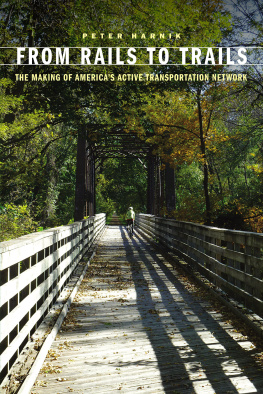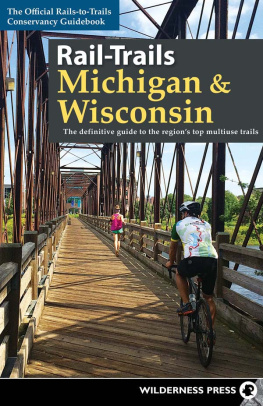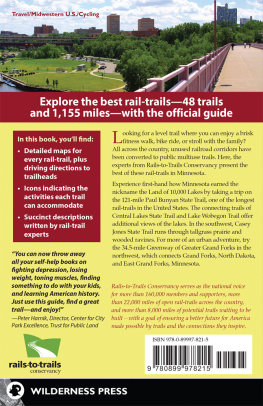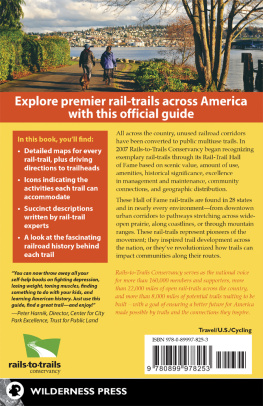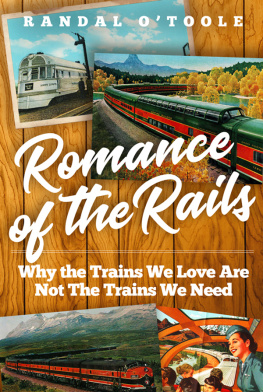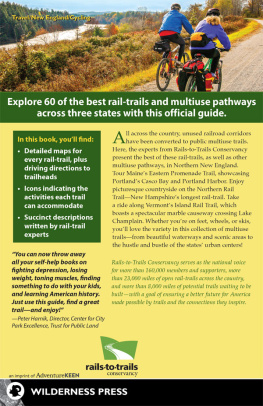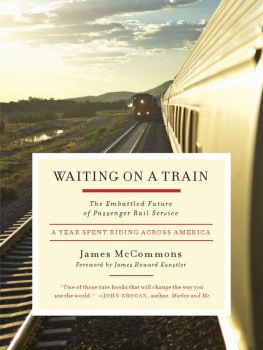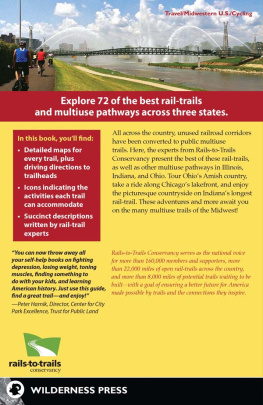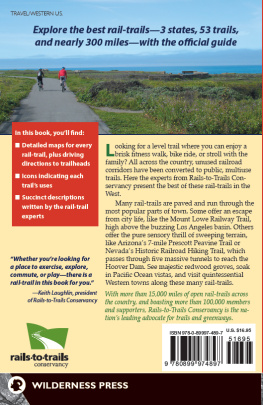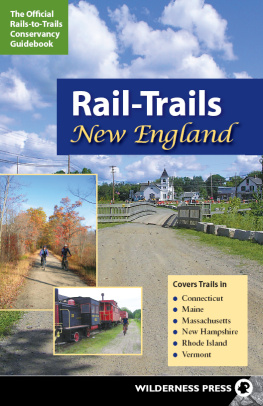A spellbinding tale of the history of the rails-to trails movement,... Harniks book gives us the inspiring story of local grit overcoming great odds for the changing benefit of all.
Charles N. Marshall, former officer of Conrail and Genesee & Wyoming railroads
Peter Harnik captures the history of a movement that has provided so many pathways for people to commute, recreate, and enjoy nature.... I hope this story will inspire emerging generations to recognize the rights-of-way for future projects that benefit our communities.
Sally Jewell, former U.S. secretary of the interior and former CEO of REI
A marvelous history.... This book tells a unique American talefrom deep in the heartland to New York City and Seattlethat will surprise and astonish you.
Ray Lahood, former U.S. secretary of transportation and former congressman
Cover designed by University of Nebraska Press; cover image courtesy Dale Garrison.
Author photo by Andrew Harnik.
All rights reserved.
Names: Harnik, Peter, author.
Title: From rails to trails: the making of Americas active transportation network / Peter Harnik.
Description: Lincoln: University of Nebraska Press, 2021. | Includes bibliographical references and index.
Subjects: LCSH : Rail-trailsUnited StatesHistory. | Rails-to-Trails ConservancyHistory. | Bicycle trailsUnited StatesHistory. | RailroadsAbandonmentUnited StatesHistory. | RailroadsRight of wayMultiple useUnited States.
Classification: LCC GV 191.4 . H 37 2021 | DDC 796.60973dc23
The publisher does not have any control over and does not assume any responsibility for author or third-party websites or their content.
A simple idea
Pathways of peace and beauty
Rail-trails forever
Lisa Hein
Contents
Figures
Maps
Illustrations
Writing the first-ever history of a movement is a daunting enterprise. As I got started my feelings on the matter fluctuated widely: Was the topic too insignificant to be worth chronicling? Why had no one tried it before? Or was the task too difficult to undertake? Had many others perhaps tried and given up in defeat? Was I ahead of the curveor behind it? As I did my research I alternated between elation over the freedom I had in charting uncharted waters and the frustration that no one else had taken the plunge ahead of me.
Fortunately, as with everything else in my life, I leaned on and learned from a wonderful circle of friends, collaborators, former colleagues, and new acquaintances to unearth the stories and elucidate the analysis of this fascinating young movement. Naturally I take full responsibility for all errors of fact, judgment, and omission, but if it hadnt been for the encouragement, information, enthusiasm, and support of these folks, this book would have foundered and sunk. They include:
Mark Ackelson, Sallie Adams, Anthony Allison, Shirley and Butch Anson, Keith Argow, Stan Bales, Henri Bartholomot, Annemarie Bauer, Karl Beard, George Bellovics, Ralph Benson, Kathy Blaha, Kay Blankenship, Mark Borleske, Rick Boucher, Roland Bowers, Linda McKenna Boxx, Mark Boyle, Becky Bremser, David Brickley, Jonathan Broder, Chris Brown, Kitty Cole Brown, Ken Bryan, Emory Bundy, Tim Burke, Champe Burnley, George Burrier, Brian Burwell, David Burwell, Sarah Campbell, Paul Ceruzzi, Ray Chambers, Doug Cheever, Jeff Ciabotti, Karin Cicelski, David Clanton, Andy Clarke, Buzz Constable, Derrick Crandall, John Crompton, Mark Cross, Dan Cunning, Paul Cunningham, Jeff Davis, Sharon Davis, Craig Della Penna, Jim Denny, Matt Dickey, Bill Dickinson, John DiMura, David Dionne, Jim Donovan, Tom Downs, Ed Dressler, Paul Dyer, Tom Eksten, Steve Elkinton, Bruce Epperson, Craig Evans, Matt Fisher, Chuck Flink, Marianne Fowler, Joan Frey, Patti Friday, Karen Gantz, Ben Gessel, Michael Gessel, Parris Glendening, David R. Goode, Kingdon Gould Jr., David Greenwood, Eli Griffen, Dorian Grilley, Gerald Grinstein, Dana Gumb, Jr., Margaret Guroff, Bill Hall, Bob Hansen, Jan Hartke, Duncan Hay, Lisa Hein, Ben Helphand, Rita Hennessey, Bob Herbst, Hal Hiemstra, Axie Hindman, Darwin Hindman, John Horsley, Brandi Horton, Oliver Houck, David Ingemie, Gabrielle Ivanier, Gerry Johnson, Roy Jones, Bob Karotko, Linda Keenan, David Kelly, Richard Kendall, Roy Kienitz, Evelyn Kitay, Randy Kline, Carl Knoch, Ron Kucera, Paul Labovitz, Joe LaCroix, Pete Lagerwey, Ray LaHood, Jean Lauver, Larry Leach, Josh Lehman, Judy Lemons, John Leshy, Greg Lindsey, Amanda Livingston, Gwen Loose, Dave Mankamyer, Greg Maxted, Cate Mayfield, Ed McBrayer, Alan McClennen, Paul McCray, Lee McElvain, Connie McGuire, Kevin Menke, Ed Merlis, Bill Metzger, Gabriel Meyer, John Milliken, Kevin Mills, David Moore, Maryanne Moore, Hugh Morris, Tom Murphy, Yvonne Mwangi, Andy Neault, Doug Nelson, Charles Newman, Ed Norton, Karen Nozik, Caroline OBoyle, Richard Orsi, Gus Ose, Kelly Pack, Bill Palmer, Pat Parenteau, Hank Parke, Bob Patten, Louis Pear, Robert Peck, Clay Peters, Dave Peterson, Tom Petri, Don Phillips, Cleve Pinnix, Paul Pritchard, John Rathbone, Peter Raynor, Tom Ridge, Barbara Robinson, Ellis Robinson, Jarrod Roll, Andy Sansom, John Sayler, Frederick Schaedtler, Fred Schaeffer, Bill Sepe, Tom Sexton, Rick Sharp, Jamie Simone, Ron Steffey, Roger Storm, Ben Sullivan, Robert Taft, Bob Thomas, Steve Thompson, Tommy Thompson, Glenn Tiedt, Wes Uhlman, Ivan Vamos, Fred Wagner, Dave Watts, John Wengert, Carol Werner, Fred Wert, David Wiggins, Mac Wilkerson, Bill Wilkinson, Frank Wilner, Steve Winslow, Sandy Wood, Robert Yates, Lori Yeich, Ron Yesney, and Lori Zoller.
I want to particularly thank Keith Laughlin and Ryan Chao, along with the entire staff of the Rails-to-Trails Conservancy, for their unstinting support and for opening up the organizations files and databases to me. I also want to give my deepest thanks to my geographic advisor Derek Strout; my railroad advisors Dan Cupper, Charlie Marshall, and Mark Reutter; my legal advisors Matt Cohen, Andrea Ferster, Charles Montange, Simon Eristoff, and Danaya Wright; my editorial advisors Jim Conroy, Diane MacEachern, Jan Schaeffer, Charles Bookman, Debby Baldwin, and Ted Mastroianni; my University of Nebraska Press team of Rob Taylor, Ann Baker, Elizabeth Zaleski, Tish Fobben, and Debbie Anderson; and very special thanks to my most creative and indefatigable research assistant Tim Balton. Lastly, as always, I salute the love and forbearance provided me during this lengthy labor by my wonderful wife, Carol Ames Parker.
There was a time in New York City, back in the 1890s, when bicycling was a glamorous sport of rich daredevilsphysically superior men and socially courageous womenbut by the time I was growing up there, in the 1950s and 60s, cycling had deteriorated into a low-status fringe activity. While biking in parks and on beachfronts was great fun for children and a source of nostalgic pride for parents standing by with Band-Aids and its all better hugs, cycling on roads with cars was too frightening for most people. And in the 1960s, there was no such thing as a road without cars.
Since I was a teen and thought myself immortal, I was never overly fearful of competing with cars. Also the average speed of traffic in Manhattan was about 8 miles an hour, and that didnt seem too terrifying. My mother was pretty relaxed about letting me do what I wanted, which included biking to my high school from West 78th Street. I grew up with a European heritage that rather honored cycling, and as a teen I was the proud recipient of my Austrian uncles old three-speed, which he had somehow taken along when he escaped Hitler. Fortunately I never had a bad run-in with a car, so my various close calls never rose to the level of visceral, cold-sweat-at-night fear. Despite all this, and even though cycling itself was an unmitigated joy, I didnt find riding in the streets of New York to be all that much fun.

